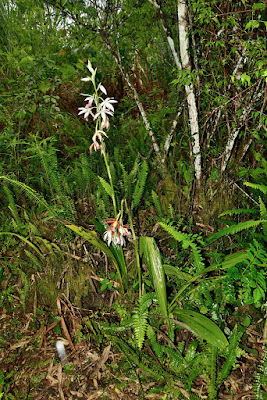Phaius tankervilleae is native to the tropical and subtropical Asia, Pacific Islands, Australia and Africa. The range of occurrence is very extensive and this variable species is also found at higher altitudes in conditions of almost moderate temperatures...
Phaius tankervilleae also called as Nun's Orchid, Kunai Orchid, Emma Tankerville's Phaius, Bletia incarvillei, Bletia tankervilleae, Calanthe bachmaensis, Calanthe speciosa, Dendrobium veratrifolium, Limodorum incarvilliae, Limodorum incarvillei, Limodorum spectabile, Limodorum tancarvilleae, Limodorum tankervilleae, Pachyne spectabilis, Phaius bicolor, Phaius blumei, Phaius blumei var assamicus, Phaius blumei var pulcher, Phaius carroni, Phaius giganteus, Phaius grandifolius, Phaius grandifolius, Phaius grandifolius, Phaius grandifolius var. superbus, Phaius incarvillei, Phaius incarvillei var speciosa, Phaius leucophaeus, Phaius mannii, Phaius oweniae, Phaius roeblingii, Phaius sinensis, Phaius tahitensis, Phaius tankervilleae f. alboflorens, Phaius tahitensis f. obtusa, Phaius tankervilleae f. veronicae, Phaius tankervilleae var. mariesii, Phaius tankervilleae var. pulchra, Phaius tankervilleae var. superbus, Phaius tenuis, Phaius veratrifolius, Tankervillia cantoniensis, is a species of the genus Phaius. This species was described by Carl Ludwig Blume in 1856.
IDENTIFY PHAIUS TANKERVILLEAE
Phaius tankervilleae is native to the tropical and subtropical Asia, Pacific Islands, Australia and Africa. The range of occurrence is very extensive and this variable species is also found at higher altitudes in conditions of almost moderate temperatures. It grows on open, grassy places in damp, rare deciduous forests that shed leaves in winter and in the muddy areas of evergreen forests. They also acclimated to higher heights in Hawaii and the Caribbean islands.
It is a hot to warm growing, large sized, terrestrial species, which reaching a height of 60 to 200 cm, with ovoid or conical, green, 3-8 cm long pseudobulbs enveloped basally by several leaf bearing sheaths with elliptic-lanceolate, acuminate, plicate, thin-textured, petiolate, 30-102 cm long leaves.
Emma Tankerville's Phaius blooms in the spring from the more than 120 cm long, erect, basal, racemose inflorescence with 10-20 flowered. The fragrant flowers are 10-13 cm in diameter. At the same time several flowers are opened. They have variable colors, they are reddish, purple, or yellowish-brown at the front and fawn, greenish or pink at the back. White forms are also known. The curly trumpet-shaped lip has bent edges with golden spots, the outside is whitish, and the inside is purple to maroon. The flowers last for 17-18 days, but the plants from Java often come to self-pollination and their flowers last shorter.
PHAIUS TANKERVILLEAE CARE AND CULTURE
Cultural information should only be used as a guide, and should be to be adapted to suit you. Your physical location; where you grow your plants, how much time you have to devote to their care, and many other factors, will need to be taken into account. Only then can you decide on the cultural methods that best suit you and your plants.
Light:
Phaius tankervilleae needs a light level of 30000-50000 lux. Filtered or diffused light is recommended.
Temperature:
It is a thermophilic plant. The average summer temperatures are 28-33 ° C and the average temperatures are 20-21 ° C, with a daily amplitude of 8-12 ° C. In winter, the average day temperature is 26-29 ° C, at night 11-15 ° C, which gives a daily difference of 13-16 ° C.
Humidity:
Emma Tankerville's Phaius needs the average humidity varies from 60% in winter and in spring to 80% in summer.
Substrate, growing media and repotting:
The substrate should be a fertile mixture for orchids with good drainage. Although the Phaius tankervilleae bloom in small containers, large ones are better because they provide the plant with stability and space for the expansive root system. Repotting is best done in early spring.
Watering:
During active growth, the plants require very large amounts of water. The substrate must be moist, but not soaked. The precipitation scheme is wet / dry depending on the season.
Fertilizer:
During the period of active growth, the plants should be fertilized every week with 1/2 of the recommended dose of fertilizer for orchids.
Rest period:
Phaius tankervilleae tolerates cold days with an average night temperature of 5 ° C. Such a cool, dry resting period is necessary to induce flowering. If the plants are grown in the same warm climate, air conditioning is necessary to ensure periodic temperature fluctuations. Watering and fertilization should be reduced. The colder the rest period, the less water the plant can tolerate.















COMMENTS